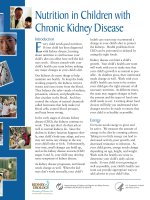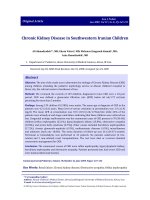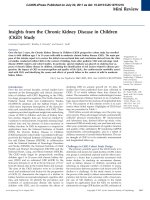Chronic Kidney Disease Edited by Monika Göőz potx
Bạn đang xem bản rút gọn của tài liệu. Xem và tải ngay bản đầy đủ của tài liệu tại đây (12.62 MB, 456 trang )
CHRONIC KIDNEY DISEASE
Edited by Monika Göőz
Chronic Kidney Disease
Edited by Monika Göőz
Published by InTech
Janeza Trdine 9, 51000 Rijeka, Croatia
Copyright © 2012 InTech
All chapters are Open Access distributed under the Creative Commons Attribution 3.0
license, which allows users to download, copy and build upon published articles even for
commercial purposes, as long as the author and publisher are properly credited, which
ensures maximum dissemination and a wider impact of our publications. After this work
has been published by InTech, authors have the right to republish it, in whole or part, in
any publication of which they are the author, and to make other personal use of the
work. Any republication, referencing or personal use of the work must explicitly identify
the original source.
As for readers, this license allows users to download, copy and build upon published
chapters even for commercial purposes, as long as the author and publisher are properly
credited, which ensures maximum dissemination and a wider impact of our publications.
Notice
Statements and opinions expressed in the chapters are these of the individual contributors
and not necessarily those of the editors or publisher. No responsibility is accepted for the
accuracy of information contained in the published chapters. The publisher assumes no
responsibility for any damage or injury to persons or property arising out of the use of any
materials, instructions, methods or ideas contained in the book.
Publishing Process Manager Jana Sertic
Technical Editor Teodora Smiljanic
Cover Designer InTech Design Team
First published March, 2012
Printed in Croatia
A free online edition of this book is available at www.intechopen.com
Additional hard copies can be obtained from
Chronic Kidney Disease, Edited by Monika Göőz
p. cm.
ISBN 978-953-51-0171-0
Contents
Preface IX
Chapter 1
ADAM Proteases as Novel Therapeutic Targets
in Chronic Kidney Disease 3
Monika Göőz
Chapter 2
Severity and Stages of Chronic Kidney Disease 13
Syed Ahmed and Gerard Lowder
Chapter 3
The New Kidney and Bone Disease: Chronic Kidney Disease –
Mineral and Bone Disorder (CKD–MBD) 25
Igor G. Nikolov, Ognen Ivanovski and Nobuhiko Joki
Chapter 4
The Prevalence of Renal Osteodystrophy in Chronic
Renal Failure Patients in Urban Niger Delta of Nigeria
U. R. Onyemekeihia, C. O. Esume,
E. Unuigbe, E. Oviasu, L. Ojogwu
Chapter 5
Relationships Among Renal Function,
Bone Turnover and Periodontal Disease 73
Akihiro Yoshihara and Lisdrianto Hanindriyo
Chapter 6
Sarcoidosis and Kidney Disease 87
Tulsi Mehta, Anirban Ganguli and Mehrnaz Haji-Momenian
Chapter 7
Origins of Cardiorenal Syndrome
and the Cardiorenal Connection 107
L. G. Bongartz, M. J. Cramer and J. A. Joles
Chapter 8
Sub-Types and Therapeutic
Management of the Cardiorenal Syndrome
Margot Davis and Sean A. Virani
Chapter 9
Atherosclerotic Renovascular Disease 149
Gen-Min Lin, Chih-Lu Han, Chung-Chi Yang
and Cheng-Chung Cheng
123
47
VI
Contents
Chapter 10
Pharmacologic Adjuvants to Reduce Erythropoietin
Therapy Dose in Anemia of Chronic Kidney Disease
and End Stage Renal Disease 161
Adeel Siddiqui, Aqeel Siddiqui and Robert Benz
Chapter 11
Molecular Mechanisms of
Nephro-Protective Action of HE-86 Liquid
Extract in Experimental Chronic Renal Failure
Li-qun He, Dong Feixia, Qiang Fu and Jun Li
175
Chapter 12
The Effects of Asymmetric Dimethylarginine (ADMA),
Nitric Oxide (NO) and Homocysteine (Hcy) on Progression
of Mild Chronic Kidney Disease (CKD): Relationship
Between Clinical and Biochemical Parameters 197
A. Atamer, S. Alisir Ecder, Y. Atamer,
Y. Kocyigit, N. Bozkurt Yigit and T. Ecder
Chapter 13
Neutrophil Activation and Erythrocyte
Membrane Protein Composition in Stage 5
Chronic Kidney Disease Patients 209
Elísio Costa, Luís Belo and Alice Santos-Silva
Chapter 14
Assessing Iron Status in CKD Patients:
New Laboratory Parameters 225
Eloísa Urrechaga, Luís Borque and Jesús F. Escanero
Chapter 15
Exogenous Fluorescent Agents for
the Determination of Glomerular Filtration Rate
Raghavan Rajagopalan and Richard B. Dorshow
Chapter 16
Modern Surgical Treatments of
Urinary Tract Obstruction 261
Bannakij Lojanapiwat
Chapter 17
Extra-Anatomic Urinary Drainage
for Urinary Obstruction 281
Michael Kimuli, John Sciberras and Stuart Lloyd
Chapter 18
Percutaneous Nephrostomy 297
Rameysh D. Mahmood, Lee Yizhi and Mark Tan M.L.
Chapter 19
Unusual Vascular Access for
Hemodialysis Therapies 315
Cesar A. Restrepo V
Chapter 20
The Role of Nephron-Sparing Surgery
(NSS) for Renal Tumours >4 cm 329
Amélie Parisel, Frederic Baekelandt,
Hein Van Poppel and Steven Joniau
251
Contents
Chapter 21
Benign Prostate Hyperplasia
and Chronic Kidney Disease 347
Ricardo Leão, Bruno Jorge Pereira and Hugo Coelho
Chapter 22
Asymptomatic Bacteriuria (ASB),
Renal Function and Hypertension 377
Suzanne Geerlings
Chapter 23
Sleep Disorders Associated with
Chronic Kidney Disease 385
Robert L. Benz, Mark R. Pressman and Iqbal Masood
Chapter 24
The Allo-Immunological Injury
in Chronic Allograft Nephropathy 401
I. Enver Khan, Rubin Zhang,
Eric E. Simon and L. Lee Hamm
Chapter 25
Prevention and Regression of Chronic
Kidney Disease and Hypertension 415
Hiroyuki Sasamura
Chapter 26
Health-Related Quality of Life in Chronic Renal
Predialysis Patients Exposed to a Prevention
Program – Medellín, 2007-2008 431
Carlos E. Yepes Delgado, Yanett M. Montoya Jaramillo,
Beatriz E. Orrego Orozco and Daniel C. Aguirre Acevedo
VII
Preface
Chronic kidney disease is an increasing health and economical problem in our world.
Obesity and diabetes mellitus, the two most common cause of CKD, are becoming
epidemic in our societies. Education on healthy lifestyle and diet is becoming more
and more important for reducing the number of type 2 diabetics and patients with
hypertension. Education of our patients is also crucial for successful maintenance
therapy. There are, however, certain other factors leading to CKD, for instance the
genetic predisposition in the case of polycystic kidney disease or type 1 diabetes,
where education alone is not enough.
When the first angiotensin converting enzyme inhibitor, Captopril, was developed in
1975 it changed not only the treatment of hypertension, but of diabetic nephropathy
and other chronic kidney diseases. In the past forty years we did not have such a
breakthrough in the treatment of CKD. However, several valuable discoveries were
made which greatly enhanced our understanding of the role of nitric oxide and
mechanisms responsible for anemia and CKD-related bone diseases. Most certainly,
dialysis techniques have developed greatly over the past seventy years and have
become available for a wide range of people. Furthermore, advanced surgical
procedures and tools were developed in the past years to resolve ureteral obstructions
originating from stones or prostate hypertrophy. These modern techniques are
discussed in our book along with currently accepted procedures for kidney cancers.
How can we further improve the treatment of CKD patients? Besides prevention, the
most important aim would be to constantly look for, and try to understand the
mechanistic details of disease development and progression. Perhaps no other disease
is as complex and complicated as CKD since the symptoms result from the constant
interaction of multiple organ systems as is the case with cardiorenal syndrome, CKDrelated anemia, and bone diseases. Because of the interdisciplinary nature of the
disease, we need continuous communication between nephrologists, surgeons, and
basic scientists, since only our joint approach can lay down the foundation of the next
(bio)medical breakthrough. The chapters of our book introduce readers to this
enthusiastic approach.
I would like to thank all of our contributors for their valuable time and expertise and
for the high quality chapters which provide a greatly enjoyable reading experience. I
X
Preface
also would like to thank my family and friends who supported me during the editing
process: my Mom and Dad, Pal and Adam, and Carol of course. I dedicate this book to
you.
Monika Göőz, MD PhD
Medical University of South Carolina
Charleston, SC,
USA
1
ADAM Proteases as Novel Therapeutic Targets
in Chronic Kidney Disease
Monika Göőz
Medical University of South Carolina, Charleston, SC
USA
1. Introduction
More than 20 million Americans suffer, and ultimately die, from chronic kidney disease
(CKD). Based on data from the National Institute of Diabetes and Digestive and Kidney
Diseases (NIDDK), the yearly cost of dialysis treatment of patients with end stage renal
disease (ESRD) is currently $35 billion [1], and this number is predicted to rise as the US
population ages and more people develop obesity, metabolic syndrome, and diabetes. CKD
is associated with progressive renal fibrosis and inflammation, and currently there is no cure
for the disease.
The most common primary illnesses which result in end stage renal disease (ESRD) are
diabetes (~37%), hypertension (~24%), glomerulonephritis (~15%), cystic kidney diseases
(~4.7%) and urologic diseases (2.5%) [1]. There were 111,000 new ESRD patients diagnosed
in 2007 and out of a total of ~500,000 ESRD patients 368,500 people received dialysis
treatment in the same year. Dialysis patients have poor quality of life due to high
hospitalization rate (458/1000 patients in 2008), high morbidity and mortality (~20%) [1].
Presently, kidney transplant is the only option for these patients to have a close to normal
life. According to the US Renal Data System 2010 [1] however, out of the ~85,000 patients
awaiting transplant about 18,000 will receive kidney since the amount of available organs
did not increase significantly above this number for several years.
Angiotensin converting enzyme inhibitors (ACEIs) and angiotensin receptor blockers
(ARBs) are widely used to attenuate the development of cardiovascular diseases and
support renal function in CKD patients. However, novel therapeutic targets are desperately
needed to effectively treat CKD and slow down disease progression.
Currently, there are about 2,000 clinical trials worldwide addressing some aspects and/or
co-morbidities of CKD [2]. These include treatment of anemia, hypertension, secondary
hyperparathyroidism, depression and inflammation among others. So far increasing
frequency and quality of dialysis did not show advantages in survival rate [2]. Similarly,
treatments targeting hypercholesterolemia [3] and hyperhomocysteinemia [4] or the usage
of statins [5] failed to increase significantly the survival of ESRD patients.
In recent years, we and others obtained exciting new data on the pathophysiological role of
the disintegrin and metalloenzyme ADAMs in renal fibrosis and CKD. This chapter is
dedicated to summerize these discoveries and discuss their significance and potential role in
the future treatment of patients with renal diseases.
2
Chronic Kidney Disease
2. Physiology of ADAMs and ADAMTS
ADAMs (a disintegrin and metalloenzymes) and ADAMTS (ADAMs with thrombospondin1-like domains) are membrane-bound multidomain proteins similar to snake venom
metalloenzymes and disintegrins. Both groups have pro-, metalloenzyme-like, disintegrinlike and cysteine-rich domains, but compared to ADAMs ADAMTS do not possess
cytoplasmic or transmembrane regions. Catalytically active ADAMs are Zn2+-dependent
endopeptidases and are best known for their sheddase activity. They cleave epidermal
growth factor ligands, cytokines and their receptors, adhesion molecules and the infamous
amyloid precursor protein among others [6]. ADAMs participate in interreceptor crosstalk
between G protein coupled receptors (like angiotensin receptors [7], bradykinin receptors [8]
and serotonin receptors [9]) and members of the tyrosine kinase receptors (epidermal
growth factors receptor, tumor necrosis factor receptor) by shedding membrane-bound proforms of tyrosine kinase ligands (Figure 1). ADAMs are indispensable for normal
development, cell proliferation and growth however, at the same time, they can drive
pathological cell division and inflammation and have major role in the development of
several proliferative and inflammatory diseases [8]. Some of the ADAMs have mutation in
their so-called hemopexin-domain (HEXXHXXGXXH) which is responsible for the Zn2+binding of the protein. These ADAMs are catalytically inactive and may have a role in cellmatrix and cell-cell interactions rather than in proteolytic processes [11].
Fig. 1. ADAMs participate in inter-receptor crosstalk: triple membrane spanning signalling.
AII: angiotensin-II, BK: bradykinin; GPCR: G protein-coupled receptor; mGF: membranebound growth factor, sGF: soluble growth factor; EGFR: epidermal growth factor receptor.
ADAM Proteases as Novel Therapeutic Targets in Chronic Kidney Disease
3
ADAMTSs are secreted proteins which anchor to extracellular matrix molecules through
their thrombospondin-1 domain [12] and are involved in proteolytic cleavage of
proteoglycans [13], and of the von Willebrand factor [14]. Both protein families can have
significant contribution to CKD progression.
2.1 Expression of ADAM enzymes in the normal kidney
There are several ADAM and ADAMTS proteins which expression was shown in the human
or murine kidney by various techniques. Histochemical analysis showed that ADAM9 was
expressed in the nephron: both in the glomerulus and in tubular epithelial cells [15].
Expression of a short form of the enzyme lacking the cytoplasmic region was also reported
in the kidney [16]. ADAM10 expression was first shown in chick kidney [17], in mouse
kidney of mesenchymal origin [18] and later in humans in the distal tubule, in the
connecting tubule, in the principal cells of the collecting duct and in the thick ascending
limb of Henle [19]. ADAM11, which is known as a disintegrin metalloenzyme primarily
expressed in the central and peripheral nervous system, was also expressed in the epithelial
cells of the collecting duct at a low level [20]. Since ADAM11 is differentially expressed
during development, it may have an important role in normal kidney morphogenesis. There
is also data on the expression of ADAM13 mRNA in the developing mouse kidney [21].
ADAM17 is a disintegrin metalloenzyme which is ubiquitously expressed in almost all
mammalian cells. It is present in the kidney [22] and its expression is upregulated in various
renal diseases in humans [23]. The mRNA of ADAM19 was present in developing human
kidney, and in the endothelial cells and in cell of the distal tubules of the adult kidney [23].
Expression of ADAM31, another proteolytically active disintegrin metalloenzyme was also
identified in the epithelium of the convoluted tubuli [24]. High mRNA level of mouse
ADAM33 was also shown in the kidney [25]. Since this protein is catalytically inactive, it
may have a role in cell-cell interaction and communication.
Of the ADAMTS proteins ADAMTS-1 is expressed at high levels in the adult mice kidney
[26], and in situ hybridization showed high level of ADAMTS-1 in the epithelia of the
developing kidney [27]. In the rat higher level of ADAMTS-1 was observed in the adult
animals compared to newborns, and expression pattern of the protease was restricted to the
renal medulla and the principal cells of the collecting ducts in the kidney [28]. ADAMTS-5
was observed in glomerular mesangial cells [29]. ADAMTS-9 [30] and ADAMTS-10 [18] are
highly expressed in the developing and adult kidney, respectively, similarly to human
ADAMTS-14, -15, -16 [31] with no known function at the present. ADAMTS-13 was shown
in healthy human kidney samples and in kidneys of patients with thrombotic
thrombocytopenic purpura by real-time PCR and immunohistochemistry. ADAMTS-13 was
present in the glomeruli as well as in the tubuli [32]. Also, various transcripts of ADAM16
were shown in the developing human and rat kidneys [33, 34].
2.1.1 ADAM and ADAMTS in kidney development - what we learned from knockout
studies
There is very few data available on the role of ADAMs and ADAMTS enzymes in kidney
development. There is evidence that expression pattern of ADAMTS-1 [27] and ADAM10
[35] and ADAM13 [21] changes in the kidney during development and that ADAMTS-9 is
4
Chronic Kidney Disease
highly expressed in the mesenchyme of the developing kidney [30]. However, as of present,
there is no detail about how knocking down ADAMs influence kidney development.
Targeted knockout of Adamts-1 in mice showed that the enzyme has an important role in
kidney development. Deletion of exon 2 (encoding part of the metalloenzyme domain)
resulted in lack of ADAMTS-1 protein in mice and high perinatal lethality of the animals
due to kidney malfunction [36]. In these animals both the cortical and medullary areas were
reduced with concomitant increase in the caliceal space. Another group found that lack of
the whole metalloenzyme domain (deletion of exon 2-4) rendered ADAMTS-1 catalytically
inactive which resulted in enlarged renal calices and fibrosis of the uteropelvic junction [37].
These animals also developed bilateral hydronephrosis and papillary atrophy shortly after
birth [38]. Since normally there is a high level of ADAMTS-1 expressed in the epithelium of
the collecting ducts and of the uteropelvic junction, and because the phenotype greatly
resembles to symptoms of the human uteropelvic obstruction, these animals can be good
models for this genetic disease.
These data also show that targeting strategies can greatly influence the evolving
phenotypes.
3. ADAMs and ADAMTSs in chronic kidney diseases
3.1 ADAMs in diabetic nephropathy
There is increasing evidence on the pathophysiological role of ADAM17 (TACE), ADAM19,
ADAMTS-13 in CKD.
ADAM17 is a most well-studied sheddase enzyme. It was originally identified as the tumor
necrosis factor (TNF)- converting (or activating) enzyme [22] or TACE. It cleaves cell
surface molecules, most importantly cytokines and growth factors [39]. By activating EGFR
ligands and TNF- ADAM17 has a central role in inflammatory and proliferative processes
both of which have crucial role in the development of CKD (Figure 2).
Fig. 2. Role of ADAM17 in CKD.
ADAM Proteases as Novel Therapeutic Targets in Chronic Kidney Disease
5
Besides initiating inflammation, TNF has important pathophysiological role in insulin
resistance (reviewed in [40]). After activation by ADAM17, the soluble homotrimer of TNF
activates the TNF receptor and downstream signaling molecules. Activation of the MAP
kinase pathway initiates serine phosphorylation of the insulin receptor substrate (IRS)
intracellularly. Being phosphorylated on serine inhibits tyrosine phosphorylation of the IRS
which results in insensitivity of the insulin receptor to extracellular insulin and contributes
the development of diabetes (Figure 3).
Fig. 3. Mechanism of TNF-induced insulin resistance
6
Chronic Kidney Disease
High glucose was also shown to promote heparin-binding growth factor (HB-EGF)
shedding through ADAM17 activation, however the exact mechanism is unknown [41].
Since ADAM17 activates secretion of TNF, pharmacological inhibitors of the enzyme were
tested on blood glucose regulation in animal model of non-obesity-related insulin resistance
(fructose-fed rats). ADAM17 inhibitor restored the animals’ insulin resistance [42]. In
another study, animals heterozygous for ADAM17 (+/-) proved to be relatively protected
from high-fat diet-induced obesity and diabetes [43].
A close structural relative of ADAM17, ADAM10 is involved in shedding of RAGE: receptor
for advanced glycation end products [44]. Since soluble RAGE can block pathophysiological
processes initiated by RAGE, ADAM10 activation may slow down development of diabetes.
As of today, we do not have data on the pathophysiological role of ADAMTS enzymes in
diabetes mellitus.
3.2 ADAMs in renal transplant dysfunction and ischemia reperfusion injury
In vitro studies modelling mechanisms of transplant rejection showed that the mRNA
expression of ADAM17 was upregulated in the kidney and that the protein expression of
the enzyme was localized next to TNF receptor II. This suggested that ADAM17 may
antagonize the effect of TNF by shedding of its receptor during transplant rejection and
therefore higher ADAM17 activity might be beneficial [45]. On the other hand, ADAM17
also co-localized with HB-EGF in experimental ischemia-reperfusion injury which suggested
that increased shedding of the growth factor may have contributed to the observed fibrotic
injury [46]. Pharmacological inhibitors targeting ADAM17 activity reduced renal tissue
injury associated with reperfusion. This confirmed that the increased enzyme activity was a
cause rather than the consequence of the tissue injury [47].
Another ADAM enzyme, ADAM19 was also implicated in allograft nephropathy however,
we do not know any mechanistic details of its actions [48].
3.3 ADAMs in renal fibrosis
Renal fibrosis is a manifestation of several pathological processes. Glomerular fibrosis can
be induced by over-activation of the renin-angiotensin system, and the developing fibrosis
and inflammation can be successfully attenuated by ADAM17 inhibitors in animal models
of the injury [7]. We showed previously that serotonin-induced mesangial cell proliferation,
which is an important component of glomerular fibrosis, can be inhibited by knocking down
ADAM17 expression and inhibiting the enzyme activity [9]. On the other hand, we also
found that ADAM17 can protect glomerular function by decreasing podocyte permeability
through inducing re-arrangement of the zonula occludens protein ZO-1 [8]. These data
suggest that depending on the cellular context the enzyme can have different effect on the
renal function. Nonetheless, inhibitors of ADAM17 decreased infiltration of macrophages
both in the glomeruli and in the interstitium in models of kidney fibrosis [7, 46] proving that
targeting ADAM17 can be beneficial for preserving renal function.
There is very few data available on ADAMTS enzymes and renal fibrosis. Unilateral ureteral
obstruction in rat induced upregulation of ADAMTS-1 in the tubular epithelial cells. Further,
ADAM Proteases as Novel Therapeutic Targets in Chronic Kidney Disease
7
secreted ADAMTS-1 of cultured epithelial cells decreased proliferation of a tubular fibroblast
cell line which suggested that ADAMTS-1 may have anti-fibrotic effect [49].
3.4 ADAMs in polycystic kidney disease (PKD)
Autosomal-recessive polycystic kidney disease (AR-PKD) is one of the most common genetic
disorders of the kidney results in end-stage renal disease. This disease leads to rapid
enlargement of the kidney through massive cysts formation. The main pathogenic process in
cyst development is the overactivation of the mislocalized EGFR in the cystic apical epithelia
(for review see [50]). Excessive shedding of the pro-proliferative growth factor, transforming
growth factor (TGF) was also observed. Since secretion of TGFis regulated by ADAM17,
therapeutic potential of ADAM17 inhibitors were explored and established in the bpk murine
model of AR-PKD [51]. In a later study, the role of TGF was not confirmed even if ADAM17
inhibitors were beneficial for attenuating cyst development in AR-PKD [52].
3.5 Thrombotic thrombocytopenic purpura (TTP)/ haemolytic-uremic syndrome (HUS)
Thrombotic thrombocytopenic purpura/haemolytic uremic syndrome are often considered
variants of a disease characterized by microangiopathic haemolytic anaemia [53]. Platelets
are consumed by spontaneously developing microscopic thrombosis. ADAMTS-13, the
enzyme which normally processes the very large von Willebrand factor (vWF) is missing
[54] or disabled [55, 56] in this disease. Therefore, the very large vWF “capture” circulating
platelets and initiates microthrombi formation. The red blood cells passing through the
damaged arteries experience excessive shear stress which leads to haemodialysis. Besides
purpura and anaemia there are often fever and neurologic symptoms present and the
disease can lead to both acute kidney failure and CKD [57, 58]. Interestingly, a recent study
which investigated plasma level of vWF in patients with chronic kidney disease of different
origin found decreased level of vWF-cleaving protease [59]. Level of vWF was higher in
stage IV patients compared to stages II and III, but whether the increased vWF contributed
to the worsening of CKD is currently not known.
4. ADAMs in kidney cancer
Several ADAM enzymes were upregulated at the message level in human renal cell
carcinomas. Compared to normal tissue mRNA levels of ADAM8, -17, -19, -28 as well as
ADAMTS-2 were upregulated. Interestingly, mRNA level of ADAMTS-1 did not change
[60]. In other studies, ADAM10 [61] and ADAM9 expression was increased in renal cancer
cells and associated with tumor progression [62] suggesting that expression of these enzyme
may be used as tumor markers. ADAM15 and -17 contributed to the migratory potential of
kidney cancer cells through activation of the EGFR [63] and ADAM17 silencing disabled the
capability of renal carcinoma cells to form in vivo tumors [64]. Therefore these enzymes
seem to have direct role in renal cancer pathophysiology.
5. Conclusion
ADAM and ADAMTS families include growing number of metalloenzymes which have
important role in kidney development and are indispensable to normal kidney function.
8
Chronic Kidney Disease
Lack or overactivation of certain ADAM enzymes (especially ADAM17 and ADAMTS-13)
can have major pathophysiological role in development of various type of CKD. Therefore,
targeting these enzymes can be an exciting novel therapeutic approach in the future and a
new hope for CKD patients.
6. Acknowledgment
This work was partly supported by the Paul Teschan Research Fund of the Dialysis Clinic
Incorporated.
7. References
[1] National Institutes of Health, National Institute of Diabetes and Digestive and Kidney
Diseases. United States Renal Data System: 2010 Atlas of CKD in the United States.
Available from />[2] Clinical Trials at the U. S. National Institute of Health. Available from
/>[3] Liu, Y., et al., Association between cholesterol level and mortality in dialysis patients: role of
inflammation and malnutrition. JAMA : the journal of the American Medical
Association, 2004. 291(4): p. 451-9.
[4] Kalantar-Zadeh, K., et al., A low, rather than a high, total plasma homocysteine is an indicator
of poor outcome in hemodialysis patients. Journal of the American Society of
Nephrology : JASN, 2004. 15(2): p. 442-53.
[5] Wanner, C., et al., Atorvastatin in patients with type 2 diabetes mellitus undergoing
hemodialysis. The New England journal of medicine, 2005. 353(3): p. 238-48.
[6] Blobel, C.P., ADAMs: key components in EGFR signalling and development. Nature reviews.
Molecular cell biology, 2005. 6(1): p. 32-43.
[7] Lautrette, A., et al., Angiotensin II and EGF receptor cross-talk in chronic kidney diseases: a
new therapeutic approach. Nature medicine, 2005. 11(8): p. 867-74.
[8] Dey, M., et al., Bradykinin decreases podocyte permeability through ADAM17-dependent
epidermal growth factor receptor activation and zonula occludens-1 rearrangement. The
Journal of pharmacology and experimental therapeutics, 2010. 334(3): p. 775-83.
[9] Gooz, M., et al., 5-HT2A receptor induces ERK phosphorylation and proliferation through
ADAM-17 tumor necrosis factor-alpha-converting enzyme (TACE) activation and heparinbound epidermal growth factor-like growth factor (HB-EGF) shedding in mesangial cells.
The Journal of biological chemistry, 2006. 281(30): p. 21004-12.
[10] Gooz, M., ADAM-17: the enzyme that does it all. Critical reviews in biochemistry and
molecular biology, 2010. 45(2): p. 146-69.
[11] Schlondorff, J. and C.P. Blobel, Metalloprotease-disintegrins: modular proteins capable of
promoting cell-cell interactions and triggering signals by protein-ectodomain shedding.
Journal of cell science, 1999. 112 ( Pt 21): p. 3603-17.
[12] Kuno, K. and K. Matsushima, ADAMTS-1 protein anchors at the extracellular matrix
through the thrombospondin type I motifs and its spacing region. The Journal of
biological chemistry, 1998. 273(22): p. 13912-7.
ADAM Proteases as Novel Therapeutic Targets in Chronic Kidney Disease
9
[13] Stanton, H., et al., Proteoglycan degradation by the ADAMTS family of proteinases.
Biochimica et biophysica acta, 2011. 1812(12): p. 1616-29.
[14] Fujikawa, K., et al., Purification of human von Willebrand factor-cleaving protease and its
identification as a new member of the metalloproteinase family. Blood, 2001. 98(6): p.
1662-6.
[15] Mahimkar, R.M., et al., Identification, cellular distribution and potential function of the
metalloprotease-disintegrin MDC9 in the kidney. Journal of the American Society of
Nephrology : JASN, 2000. 11(4): p. 595-603.
[16] Hotoda, N., et al., A secreted form of human ADAM9 has an alpha-secretase activity for APP.
Biochemical and biophysical research communications, 2002. 293(2): p. 800-5.
[17] Hall, R.J. and C.A. Erickson, ADAM 10: an active metalloprotease expressed during avian
epithelial morphogenesis. Developmental biology, 2003. 256(1): p. 146-59.
[18] Somerville, R.P., K.A. Jungers, and S.S. Apte, Discovery and characterization of a novel,
widely expressed metalloprotease, ADAMTS10, and its proteolytic activation. The Journal
of biological chemistry, 2004. 279(49): p. 51208-17.
[19] Schramme, A., et al., Characterization of CXCL16 and ADAM10 in the normal and
transplanted kidney. Kidney international, 2008. 74(3): p. 328-38.
[20] Rybnikova, E., et al., Developmental regulation and neuronal expression of the cellular
disintegrin ADAM11 gene in mouse nervous system. Neuroscience, 2002. 112(4): p. 92134.
[21] Lin, J., C. Redies, and J. Luo, Regionalized expression of ADAM13 during chicken embryonic
development. Developmental dynamics : an official publication of the American
Association of Anatomists, 2007. 236(3): p. 862-70.
[22] Black, R.A., et al., A metalloproteinase disintegrin that releases tumour-necrosis factor-alpha
from cells. Nature, 1997. 385(6618): p. 729-33.
[23] Melenhorst, W.B., et al., ADAM17 upregulation in human renal disease: a role in modulating
TGF-alpha availability? American journal of physiology. Renal physiology, 2009.
297(3): p. F781-90.
[24] Liu, L. and J.W. Smith, Identification of ADAM 31: a protein expressed in Leydig cells and
specialized epithelia. Endocrinology, 2000. 141(6): p. 2033-42.
[25] Gunn, T.M., et al., Identification and preliminary characterization of mouse Adam33. BMC
genetics, 2002. 3: p. 2.
[26] Miles, R.R., et al., ADAMTS-1: A cellular disintegrin and metalloprotease with
thrombospondin motifs is a target for parathyroid hormone in bone. Endocrinology, 2000.
141(12): p. 4533-42.
[27] Thai, S.N. and M.L. Iruela-Arispe, Expression of ADAMTS1 during murine development.
Mechanisms of development, 2002. 115(1-2): p. 181-5.
[28] Gunther, W., et al., Distribution patterns of the anti-angiogenic protein ADAMTS-1 during
rat development. Acta histochemica, 2005. 107(2): p. 121-31.
[29] McCulloch, D.R., et al., Adamts5, the gene encoding a proteoglycan-degrading
metalloprotease, is expressed by specific cell lineages during mouse embryonic development
and in adult tissues. Gene expression patterns : GEP, 2009. 9(5): p. 314-23.
[30] Jungers, K.A., et al., Adamts9 is widely expressed during mouse embryo development. Gene
expression patterns : GEP, 2005. 5(5): p. 609-17.
10
Chronic Kidney Disease
[31] Cal, S., et al., Cloning, expression analysis, and structural characterization of seven novel
human ADAMTSs, a family of metalloproteinases with disintegrin and thrombospondin-1
domains. Gene, 2002. 283(1-2): p. 49-62.
[32] Manea, M., et al., Podocytes express ADAMTS13 in normal renal cortex and in patients
with thrombotic thrombocytopenic purpura. British journal of haematology, 2007.
138(5):
p. 651-62.
[33] Surridge, A.K., et al., Characterization and regulation of ADAMTS-16. Matrix biology :
journal of the International Society for Matrix Biology, 2009. 28(7): p. 416-24.
[34] Joe, B., et al., Positional identification of variants of Adamts16 linked to inherited hypertension.
Human molecular genetics, 2009. 18(15): p. 2825-38.
[35] Stuart, R.O., K.T. Bush, and S.K. Nigam, Changes in gene expression patterns in the ureteric
bud and metanephric mesenchyme in models of kidney development. Kidney
international, 2003. 64(6): p. 1997-2008.
[36] Mittaz, L., et al., Neonatal calyceal dilation and renal fibrosis resulting from loss of Adamts-1
in mouse kidney is due to a developmental dysgenesis. Nephrology, dialysis,
transplantation : official publication of the European Dialysis and Transplant
Association - European Renal Association, 2005. 20(2): p. 419-23.
[37] Shindo, T., et al., ADAMTS-1: a metalloproteinase-disintegrin essential for normal growth,
fertility, and organ morphology and function. The Journal of clinical investigation,
2000. 105(10): p. 1345-52.
[38] Yokoyama, H., et al., A disintegrin and metalloproteinase with thrombospondin motifs
(ADAMTS)-1 null mutant mice develop renal lesions mimicking obstructive nephropathy.
Nephrology, dialysis, transplantation : official publication of the European Dialysis
and Transplant Association - European Renal Association, 2002. 17 Suppl 9: p. 3941.
[39] Sunnarborg, S.W., et al., Tumor necrosis factor-alpha converting enzyme (TACE) regulates
epidermal growth factor receptor ligand availability. The Journal of biological chemistry,
2002. 277(15): p. 12838-45.
[40] Taniguchi, C.M., B. Emanuelli, and C.R. Kahn, Critical nodes in signalling pathways:
insights into insulin action. Nature reviews. Molecular cell biology, 2006. 7(2): p. 8596.
[41] Uttarwar, L., et al., HB-EGF release mediates glucose-induced activation of the epidermal
growth factor receptor in mesangial cells. American journal of physiology. Renal
physiology, 2011. 300(4): p. F921-31.
[42] Togashi, N., et al., Effect of TNF-alpha--converting enzyme inhibitor on insulin resistance in
fructose-fed rats. Hypertension, 2002. 39(2 Pt 2): p. 578-80.
[43] Serino, M., et al., Mice heterozygous for tumor necrosis factor-alpha converting enzyme
are protected from obesity-induced insulin resistance and diabetes. Diabetes, 2007. 56(10):
p. 2541-6.
[44] Zhang, L., et al., Receptor for advanced glycation end products is subjected to protein
ectodomain shedding by metalloproteinases. The Journal of biological chemistry, 2008.
283(51): p. 35507-16.
ADAM Proteases as Novel Therapeutic Targets in Chronic Kidney Disease
11
[45] Wang, J., et al., The role of tumor necrosis factor-alpha converting enzyme in renal transplant
rejection. American journal of nephrology, 2010. 32(4): p. 362-8.
[46] Mulder, G.M., et al., ADAM17 up-regulation in renal transplant dysfunction and nontransplant-related renal fibrosis. Nephrology, dialysis, transplantation : official
publication of the European Dialysis and Transplant Association - European Renal
Association, 2011.
[47] Souza, D.G., et al., Effects of PKF242-484 and PKF241-466, novel dual inhibitors of TNFalpha converting enzyme and matrix metalloproteinases, in a model of intestinal
reperfusion injury in mice. European journal of pharmacology, 2007. 571(1): p. 72-80.
[48] Melenhorst, W.B., et al., Upregulation of ADAM19 in chronic allograft nephropathy.
American journal of transplantation : official journal of the American Society
of Transplantation and the American Society of Transplant Surgeons, 2006. 6(7):
p. 1673-81.
[49] Nakamura, A., et al., Expression and significance of a disintegrin and metalloproteinase with
thrombospondin motifs (ADAMTS)-1 in an animal model of renal interstitial fibrosis
induced by unilateral ureteral obstruction. Experimental and toxicologic pathology :
official journal of the Gesellschaft fur Toxikologische Pathologie, 2007. 59(1): p. 1-7.
[50] Torres, V.E. and P.C. Harris, Mechanisms of Disease: autosomal dominant and
recessive polycystic kidney diseases. Nature clinical practice. Nephrology, 2006. 2(1): p.
40-55; quiz 55.
[51] Dell, K.M., et al., A novel inhibitor of tumor necrosis factor-alpha converting enzyme
ameliorates polycystic kidney disease. Kidney international, 2001. 60(4): p. 1240-8.
[52] Nemo, R., N. Murcia, and K.M. Dell, Transforming growth factor alpha (TGF-alpha) and
other targets of tumor necrosis factor-alpha converting enzyme (TACE) in murine
polycystic kidney disease. Pediatric research, 2005. 57(5 Pt 1): p. 732-7.
[53] Desch, K. and D. Motto, Is there a shared pathophysiology for thrombotic thrombocytopenic
purpura and hemolytic-uremic syndrome? Journal of the American Society of
Nephrology : JASN, 2007. 18(9): p. 2457-60.
[54] Sasahara, Y., et al., Deficient activity of von Willebrand factor-cleaving protease in
patients with Upshaw-Schulman syndrome. International journal of hematology, 2001.
74(1): p. 109-14.
[55] Coppo, P., et al., Severe ADAMTS13 deficiency in adult idiopathic thrombotic
microangiopathies defines a subset of patients characterized by various autoimmune
manifestations, lower platelet count, and mild renal involvement. Medicine, 2004. 83(4):
p. 233-44.
[56] Veyradier, A., et al., Severe deficiency of the specific von Willebrand factor-cleaving protease
(ADAMTS 13) activity in a subgroup of children with atypical hemolytic uremic
syndrome. The Journal of pediatrics, 2003. 142(3): p. 310-7.
[57] George, J.N., ADAMTS13, thrombotic thrombocytopenic purpura, and hemolytic uremic
syndrome. Current hematology reports, 2005. 4(3): p. 167-9.
[58] Bramham, K., et al., ADAMTS-13 deficiency: can it cause chronic renal failure? Nephrology,
dialysis, transplantation : official publication of the European Dialysis and
Transplant Association - European Renal Association, 2011. 26(2): p. 742-4.
12
Chronic Kidney Disease
[59] Lu, G.Y., et al., Significance of plasma von Willebrand factor level and von Willebrand factorcleaving protease activity in patients with chronic renal diseases. Chinese medical
journal, 2008. 121(2): p. 133-6.
[60] Roemer, A., et al., Increased mRNA expression of ADAMs in renal cell carcinoma and their
association with clinical outcome. Oncology reports, 2004. 11(2): p. 529-36.
[61] Doberstein, K., J. Pfeilschifter, and P. Gutwein, The transcription factor PAX2 regulates
ADAM10 expression in renal cell carcinoma. Carcinogenesis, 2011. 32(11): p. 1713-23.
[62] Fritzsche, F.R., et al., ADAM9 is highly expressed in renal cell cancer and is associated with
tumour progression. BMC cancer, 2008. 8: p. 179.
[63] Schafer, B., et al., Distinct ADAM metalloproteinases regulate G protein-coupled receptorinduced cell proliferation and survival. The Journal of biological chemistry, 2004.
279(46): p. 47929-38.
[64] Franovic, A., et al., Multiple acquired renal carcinoma tumor capabilities abolished upon
silencing of ADAM17. Cancer research, 2006. 66(16): p. 8083-90.
2
Severity and Stages of Chronic Kidney Disease
Syed Ahmed and Gerard Lowder
Internal Medicine, Harbor Hospital, Baltimore,
USA
1. Introduction
Nearly ten years ago Nephrologists began using asystem of classification for chronic kidney
disease (CKD). This was established in 2002 by the Kidney Disease Outcome Quality
Initiative (KDOQI) to estimate kidney function in a given patient regardless of the etiology
of the primary insult to the kidneys. Physicians were able place their patients in stages from
mild disease to end stage renal disease (ESRD).CKD is defined as glomerular filtration rate
(GFR) below 60 ml/min per 1.73 m2 for 3 months or more.
Each stage served as a “mile marker” on life’s road for the patient with CKD. The natural
history of CKD usually is a steady decline in kidney function, as found in the relationship
between the reciprocal of serum creatinine values and time. A percentage of patients do not
follow this linear pattern, suggesting either worsening or improvement in their kidney
function. Factors which may cause worsening of CKD in such individuals are often
infections, dehydration, poor control of systemic blood pressure and exposure to
nephrotoxins, in particular nonsteroidal anti-inflamatorydrugs and radiocontrast agents.
Other individuals who do not follow the steady decline may actually show improvement in
their GFR. The potential to improve the natural history of CKD is through tight blood
pressure control and inhibition of rennin-angiotensin-aldosterone system.
2. Stages of chronic kidney disease
The early stages of kidney dysfunction are often clinically silent, especially when the
condition is only slowly progressive and symptoms are nonspecific. Stages 1 & 2 show
decreased kidney function without signs or symptoms of disease although the estimated
GFR is less than 120 ml/min per 1.73 m2 but greater than 60 ml/min per 1.73 m2. The rate of
progression is influenced by a wide range of factors which may or may not have the
potential of modification and varies among different individuals and with the underlying
cause of nephropathy.When the patient enters Stage 3 he or she has lost approximately half
their kidney function. It is less likely for the kidney disease to progress unless more than
50% of the nephron function is lost. For example, individuals with a solitary kidney after
unilateral nephrectomy for living kidney donation usually do not progress to
CKD.Increased risk of natural progression with less than 50% of nephron loss can occur in
persons of African ancestry with hypertensive nephrosclerosis. In 2008, the U.K National
Institute of Health and Clinical Excellence (NICE) sub divided the stage 3 into 3A and 3B
with estimated GFRs of 45 to 59 ml/min per 1.73 m2 and 44 to 30 ml/min per 1.73 m2









